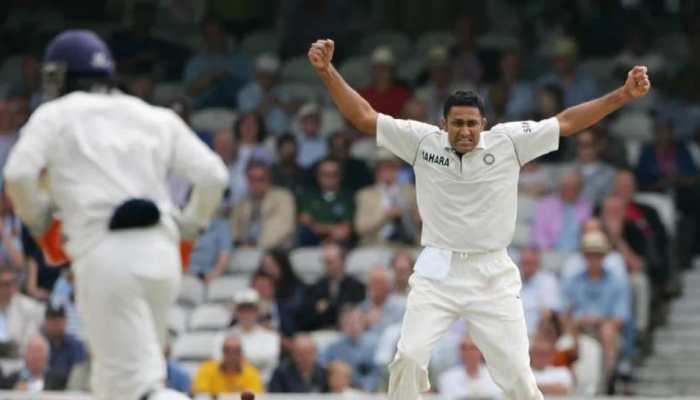Omicron driven third wave likely to hit India in Feb: Covid Supermodel panel
"Third wave is likely to arrive early next year in India. It should be milder than the second wave due to a large-scale immunity present in the country now. There will definitely be a third wave," said Vidyasagar, head of the National COVID-19 Supermodel Committee.
- It is extremely unlikely that the third wave will see more daily cases than the second wave
- India will not have more than two lakh cases per day in case the third wave grips the country
Trending Photos
) Image credit: PTI
Image credit: PTI New Delhi: Daily COVID-19 caseload in India that is currently around 7,500 infections is expected to increase once the Omicron starts displacing Delta as the dominant variant, informed members of the National COVID-19 Supermodel Committee and predicted the third wave in India early year.
Vidyasagar, who is also the head of the National COVID-19 Supermodel Committee, said that India will have Omicron`s third wave but it will be milder than the second wave.
"Third wave is likely to arrive early next year in India. It should be milder than the second wave due to a large-scale immunity present in the country now. There will definitely be a third wave. Right now, we are at around 7,500 cases per day which is sure to go up once Omicron starts displacing Delta as the dominant variant," he told ANI.
Vidyasagar, who is also a professor at the Indian Institute of Technology (IIT) in Hyderabad, said that it`s unlikely that India will see more daily cases than the second wave.
"It is extremely unlikely that the third wave will see more daily cases than the second wave. Please remember that the Government of India started vaccinating ordinary Indians (i.e., other than front-line workers) only starting March 1, which was just about the time that the Delta variant hit. So the Delta variant hit a population that was 100 per cent vaccine-naive, other than the frontline workers."
He further said that according to a sero-survey, a tiny fraction has left that hasn`t come into contact with delta virus, "Now we have sero-prevalence of 75 per cent to 80 per cent (prior exposure), first dose for 85 per cent of adults, both doses for 55 per cent of adults, and a "reach" for the pandemic of 95 per cent (meaning that only a tiny fraction of the public has not come into contact with the virus)."
"So the third wave will not see as many as daily cases as the second wave. We have also built up our capacity based on that experience, so we should be able to cope without difficulty," he said. Explaining further, the IIT professor said that the number of cases would depend on two factors, each of which is unknown at present. "First, what is the extent to which Omicron bypasses natural immunity obtained by prior exposure to Delta," he said.
Citing the second reason, he said, "Second, what is the extent to which Omicron bypasses the immunity conferred by vaccination. Because these are not known, we have generated various "scenarios," assuming (for example) 100 per cent vaccine protection remains, or only 50 per cent remains, or all of it goes away. The same for natural immunity escape. For each scenario, we project the number of cases that could result."
According to Vidyasagar, in the worst scenario, India will not have more than two lakh cases per day in case the third wave grips the country."I emphasize that these are projections, not predictions. We can start making predictions once we know how the virus is behaving in the Indian population. Based on our simulations, in the worst scenario that we have simulated, namely total loss of immunity conferred due to vaccination and maximum loss of naturally induced immunity, the number of cases remains below 1.7 to 1.8 lakh cases per day. This is less than half of the peak during the second wave."
The panel`s other member, Maninda Agrawal, told ANI, "India is expected to report one lakh to two lakh cases per day which will be less than the second wave." Elaborating on the record surge in COVID-19 infections, Agrawal said that the UK has high vaccine penetration (but mostly with mRNA vaccines), but low sero-prevalence.
"India has both high sero-prevalence which gives a lot of natural immunity, as well as high vaccine penetration. The UK also has an older population as well as more problems with obesity etc. This is why yesterday the UK had 93,045 cases while India, with 20 times the population, had 7,145 cases. In my view, people trying to draw inferences about what would happen in India, based on what is happening in the UK, would be making a major error."
"If we look at South Africa, and specifically the Gauteng Province where Omicron was first identified, we see a trend of a rapid rise in cases, but hospitalizations initially not rising at the same level and are now beginning to plateau. The situation in South Africa is the inverse of that in the USA that has a low vaccine penetration but high sero-prevalence, (India has both parameters high, as mentioned above.)," he said.
"It allows us to learn the difference between vaccine and natural immunity. However, the effect of Omicron in the UK cannot be directly translated to India due to very different levels of natural immunity in the two countries," said Agarwal. The panel assumes that community transmission of Omicron has been already started. "Just continue to comply with COVID appropriate behaviour. Prevention is better than cure," said Vidyasagar.
Stay informed on all the latest news, real-time breaking news updates, and follow all the important headlines in india news and world News on Zee News.
Live Tv







)
)
)
)
)
)
)
)
)
)
